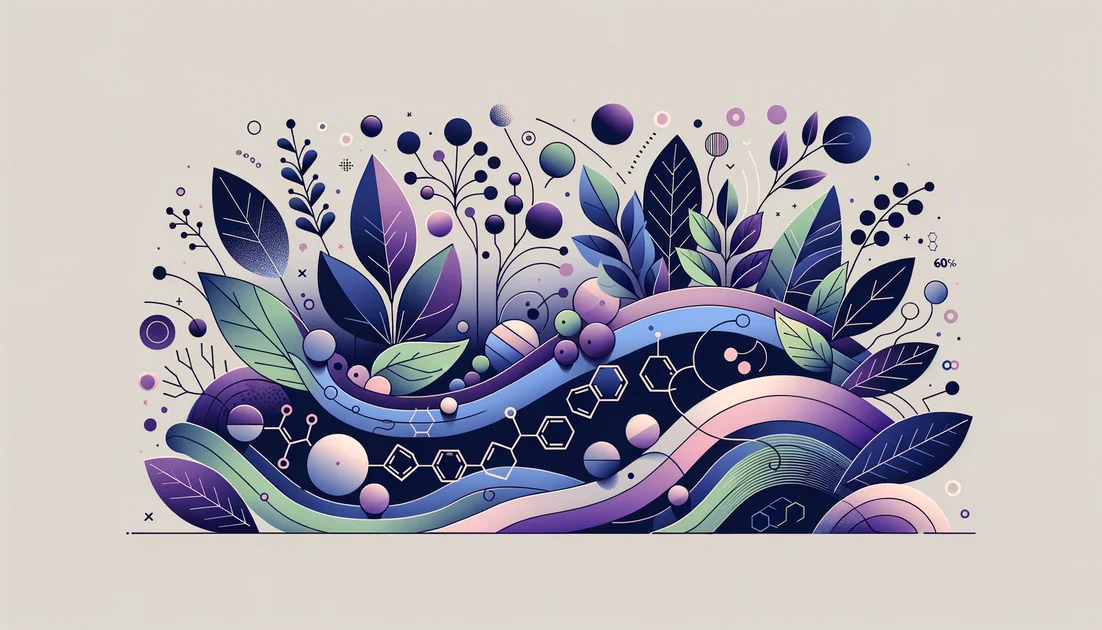
The Red Wine Riddle: How Resveratrol Leapt from a Plant's Defense to a Measured Human Promise
A TV segment in 1991 suggested the French owed their strong hearts to red wine. The world raised its glass. Yet the compound most blamed for the magic—resveratrol—exists in wine at whisper-levels, far below doses used in studies. So what does resveratrol really do, and for whom?
- Evidence
- Promising
- Immediate Effect
- No → 6-12 weeks
- Wears Off
- Gradually over weeks
From poisonous lilies to prime-time fame
In 1939, Japanese chemist Michio Takaoka pried a new molecule from a toxic lily and later from the roots of a knotweed that crawls along riverbanks: resveratrol.[1] The molecule slept in obscurity until a 1997 Science paper showed it could block multiple steps of cancer development in lab systems—an unusual three-act performance for a single plant compound.[2] As the lead investigator John Pezzuto put it, "The big surprise was resveratrol.. it occurs in more than 70 plants," adding that its anti-inflammatory action came "with no signs of toxicity" in early models.[3] Then came the "French paradox." In 1992, Serge Renaud and Michel de Lorgeril proposed that, despite a rich-fat diet, France's lower heart-disease mortality might have something to do with wine—and by extension, its polyphenols like resveratrol.[4] But here's the rub: a five-ounce glass of red wine typically holds about 0.2–0.5 mg of trans-resveratrol; even high-resveratrol varietals rarely top a few milligrams per liter.[5] In other words, wine's resveratrol is too sparse to explain major health effects by itself.
What resveratrol actually does inside you (minus the jargon)
Cells keep a maintenance crew that fixes wear-and-tear and tunes energy output. In animals, resveratrol nudges that crew—proteins that help cells burn fuel more efficiently and clean up damage—by acting like a "volume knob," not a sledgehammer. Early fights over whether resveratrol directly flips on a key maintenance foreman (SIRT1) gave way to clearer pictures: in 2013, researchers showed resveratrol can allosterically goose SIRT1's activity under the right conditions; later structural work mapped how this "fit" depends on the docking groove and the protein's natural clients.[6][7] Other work traced an indirect route too: resveratrol can inhibit certain phosphodiesterases, ripple cAMP upward, and ultimately switch on energy-sensing circuits—think of it as lifting a speed limit on cellular power plants.[8]
The inconvenient pharmacology
Here's the paradox beneath the paradox: resveratrol is well absorbed, but your gut and liver rush to tag and ship it out. Less than 1% may circulate as the free parent compound; most becomes sulfates and glucuronides within minutes.[9][10] That helps explain why dramatic lab effects don't always translate one-to-one in humans—and why researchers are testing smarter delivery (for example, cyclodextrin complexes) to raise blood levels.[11]
What humans see so far
Metabolic health: Meta-analyses in type 2 diabetes find modest but real improvements. Larger doses (≥500–1000 mg/day) have lowered fasting glucose and trimmed blood pressure; effects on lipids are mixed.[12][13] A tightly controlled crossover trial in 11 obese men found 150 mg/day for 30 days shifted muscle toward cleaner fuel use, lowered liver fat, and nudged systolic pressure down—metabolic fingerprints that mirror calorie restriction.[14]
Joints: In a 90-day randomized trial, adding 500 mg/day resveratrol to standard meloxicam for knee osteoarthritis reduced pain and inflammatory markers more than meloxicam alone.[15]
Brain aging: In mild–moderate Alzheimer's disease, a year of high-dose, pharmaceutical-grade resveratrol altered spinal-fluid biomarkers and signals of blood–brain barrier integrity, without clear cognitive benefit. "The results are very interesting," said principal investigator R. Scott Turner, "but [they] cannot be used to recommend resveratrol."[16][17]
The twist
In healthy, older men undertaking high-intensity training, 250 mg/day resveratrol actually blunted some exercise gains—smaller jumps in aerobic capacity and no drop in blood pressure versus placebo.[18] Antioxidants can sometimes quiet the very sparks muscles use to adapt.
Culture and roots
Long before supplement bottles, East Asian healers used the knotweed root (Hu Zhang) for heat, swelling, and "stagnation." Today, most U.S. supplements derive resveratrol from this same Japanese knotweed, not grapes.[5]
How thoughtful users approach it
If you decide to experiment, think like a scientist:
Dose and time: Human studies showing metabolic shifts often used 150–1000 mg/day for 4–12 weeks; osteoarthritis benefits appeared by 12 weeks at 500 mg/day (as an add-on).[14][15][12] Effects are not immediate—weeks, not days.
Quality: Look for products with independent testing. The USP Verified Mark means the label matches the contents, contaminants are below limits, and tablets disintegrate properly.[19]
Context: Because resveratrol can inhibit platelet aggregation in lab and human studies, be cautious if you take anticoagulants/antiplatelets or have a bleeding disorder; major centers advise discussing it with your clinician.[20][21]
Expectations: Wine isn't a delivery system; typical glasses provide fractions of a milligram, far below study doses.[5]
"The big surprise was resveratrol.. it occurs in more than 70 plants," noted John Pezzuto when his team first spotlighted its broad anticancer potential in 1997.[3]
"The results are very interesting," R. Scott Turner said of the Alzheimer's trial, "but [they] cannot be used to recommend resveratrol."[16]
"There has never been a drug that binds to a protein to make it run faster in the way that resveratrol activates SIRT1," argued David Sinclair as his lab mapped the activation mechanism—an ambitious claim that helped fuel both discovery and debate.[6]
What's next
Scientists are pursuing better-absorbed forms and delivery systems, and refining where resveratrol helps—or hinders—real people. The lesson so far is clear: a plant's emergency shield can, in some contexts, tune human biology. But translating whispers from a wineglass into medicine takes patience, precision, and humility.
Key takeaways
- •Wine contains whisper-level resveratrol—typically around or below 0.5 mg per glass—far below study doses, so don't rely on wine for effects.
- •Oral bioavailability of free resveratrol is very low due to rapid conjugation, which helps explain why high supplemental doses are tested.
- •Human studies most often use 150–1000 mg/day for 4–12 weeks; split dosing with meals is common due to rapid metabolism.
- •Best-supported benefits are modest: small improvements in fasting glucose and blood pressure, with possible add-on relief in knee osteoarthritis (500 mg/day with NSAIDs).
- •Who might benefit: adults with type 2 diabetes seeking adjunct metabolic support; those with knee OA under clinician guidance; alcohol-avoiders wanting standardized polyphenol exposure.
- •Cautions: it can reduce platelet aggregation—discuss use if you take warfarin, clopidogrel, aspirin, or before surgery; higher doses (≥1 g/day) more often cause GI upset.
You might also like
Explore more of our evidence-led investigations, comparisons, and guides across every article style.

Source Naturals
Veteran formulator with rigorous in-house testing—and a transparency gap

Liposomal Vitamin C (liposome-encapsulated ascorbic acid) vs Standard Vitamin C (ascorbic acid; tablets/capsules)
For maximizing absorption per dose, choose liposomal vitamin C; RCTs show higher plasma and leukocyte exposure vs standard tablets at the same milligram dose. For value at routine intakes, standard vitamin C suffices—split doses if needed. [1][2][9]


Echinacea (Echinacea purpurea, E. angustifolia, E. pallida)
On a dusty Nebraska afternoon in the late 1800s, an exuberant folk doctor allegedly offered to prove his remedy by letting a rattlesnake bite him—and then dosing himself with echinacea. The tale was reprinted by Eclectic physicians and helped launch a prairie wildflower into medical fame. Whether or not the stunt happened exactly as told, it captures echinacea's enduring paradox: beloved in practice, debated in trials, and now—surprisingly—reshaped by the bacteria that live inside the plant itself. [2][3]


Tocotrienols
The stealthier cousins of vitamin E—built with springy tails that move differently in cell membranes and behave differently in your body.
